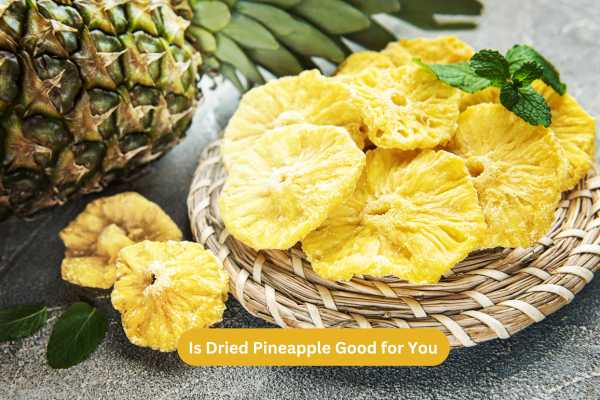Dried pineapple has become a popular snack across the UK — from office lunchboxes to supermarket health aisles. Its tropical sweetness, chewy texture, and long shelf life make it a convenient choice for those looking to satisfy a sweet craving naturally. But is dried pineapple actually good for you? As a nutritionist would explain, the answer depends on how it’s prepared, how much you eat, and what your overall diet looks like.

In this article, we’ll explore the nutritional value of dried pineapple, its health benefits, possible downsides, and the best ways to include it in a balanced diet.
What Is Dried Pineapple?
Dried pineapple is made by removing most of the water content from fresh pineapple slices, usually through air drying or dehydration. This process intensifies the fruit’s flavour and sweetness while significantly extending its shelf life.
However, not all dried pineapples are equal. Some commercial varieties are coated in added sugar or preserved with sulphites, while others are unsweetened and naturally dried. The nutritional quality can vary greatly depending on how it’s processed.
Nutritional Profile of Dried Pineapple
When compared to fresh pineapple, dried pineapple is far more concentrated in both nutrients and calories. Here’s what you can typically expect per 40-gram serving of unsweetened dried pineapple:
-
Calories: Around 140
-
Carbohydrates: 34–36 grams
-
Sugar: 25–30 grams (natural fruit sugars)
-
Fibre: 2–3 grams
-
Protein: Less than 1 gram
-
Vitamin C: Small amounts remain, though much is lost during drying
-
Manganese, copper, and B vitamins: Still present in moderate amounts
Because the water has been removed, the nutrients become more concentrated. However, so do the sugars and calories, which is something to keep in mind if you’re watching your intake.
Health Benefits of Dried Pineapple
1. A Natural Source of Quick Energy
Dried pineapple is rich in natural sugars, making it an excellent source of quick energy. This makes it ideal for athletes, hikers, or anyone needing a pre- or post-workout snack. Its carbohydrates replenish glycogen stores, supporting endurance and recovery.
2. Good for Digestion
Like fresh pineapple, the dried version contains dietary fibre, which aids digestion and supports gut health. Fibre helps maintain regular bowel movements, prevents constipation, and contributes to a feeling of fullness.
Additionally, pineapple contains bromelain, an enzyme that assists in breaking down proteins and reducing inflammation. While much of bromelain is lost in drying, trace amounts may still provide mild digestive benefits.
3. Rich in Antioxidants
Dried pineapple retains many of the antioxidants found in fresh pineapple, including phenolic compounds and flavonoids. These help protect cells from oxidative stress and support the immune system. Regular consumption of antioxidant-rich foods is associated with reduced risk of chronic conditions like heart disease and certain cancers.
4. Supports Bone Health
Pineapple is a natural source of manganese, a mineral that plays a vital role in bone formation, metabolism, and antioxidant defence. Including dried pineapple in moderation can help contribute to your daily mineral intake.
Potential Drawbacks
While dried pineapple offers nutritional benefits, it’s also important to be aware of its downsides:
1. High in Sugar and Calories
The dehydration process concentrates natural sugars, which can make dried pineapple quite high in calories. Even without added sugar, a small handful can contain the same sugar content as several slices of fresh pineapple. Overeating can lead to unwanted calorie and sugar intake, particularly for those managing blood sugar levels or weight.
2. Added Sugars in Commercial Varieties
Many store-bought dried pineapple products in the UK are candied — meaning extra sugar or syrup has been added during processing. This can double the sugar content and reduce the fruit’s overall nutritional value. Always check the label for “unsweetened” or “no added sugar” options.
3. Possible Sulphite Sensitivity
Some brands use sulphites as preservatives to maintain colour and freshness. While safe for most people, sulphites can trigger sensitivities or asthma symptoms in some individuals. Opting for sulphite-free dried pineapple is a safer choice if you’re sensitive to additives.
How to Enjoy Dried Pineapple Healthily
The key to enjoying dried pineapple is moderation and mindful pairing. Here are some practical tips from a nutritionist’s perspective:
-
Portion wisely: A small handful (about 30–40 grams) is enough for a satisfying snack.
-
Pair with protein or healthy fats: Combine with nuts, seeds, or yoghurt to balance the sugar content and promote sustained energy.
-
Use in homemade mixes: Add to trail mixes, porridge, or overnight oats for a natural sweet touch.
-
Choose wisely: Look for unsweetened, sulphite-free dried pineapple from reputable UK health food shops.
Dried Pineapple vs Fresh Pineapple
Fresh pineapple contains more vitamin C, water, and enzymes like bromelain, making it better for hydration and digestion. Dried pineapple, on the other hand, is more convenient and portable. Both have their place in a balanced diet — fresh for hydration and light snacking, dried for energy on the go.
The Bottom Line
So, is dried pineapple good for you? Yes — in moderation. It’s a naturally sweet, energy-rich snack that offers valuable fibre, antioxidants, and minerals. However, its high sugar concentration and calorie density mean it’s best enjoyed in small portions, especially if you’re managing your sugar intake.
For the healthiest choice, always opt for unsweetened, sulphite-free varieties, and balance your intake with other nutrient-dense foods.
Whether you sprinkle it on your morning porridge, toss it in a trail mix, or enjoy a few pieces on the go, dried pineapple can be a tasty and nourishing addition to your diet — when eaten mindfully.

